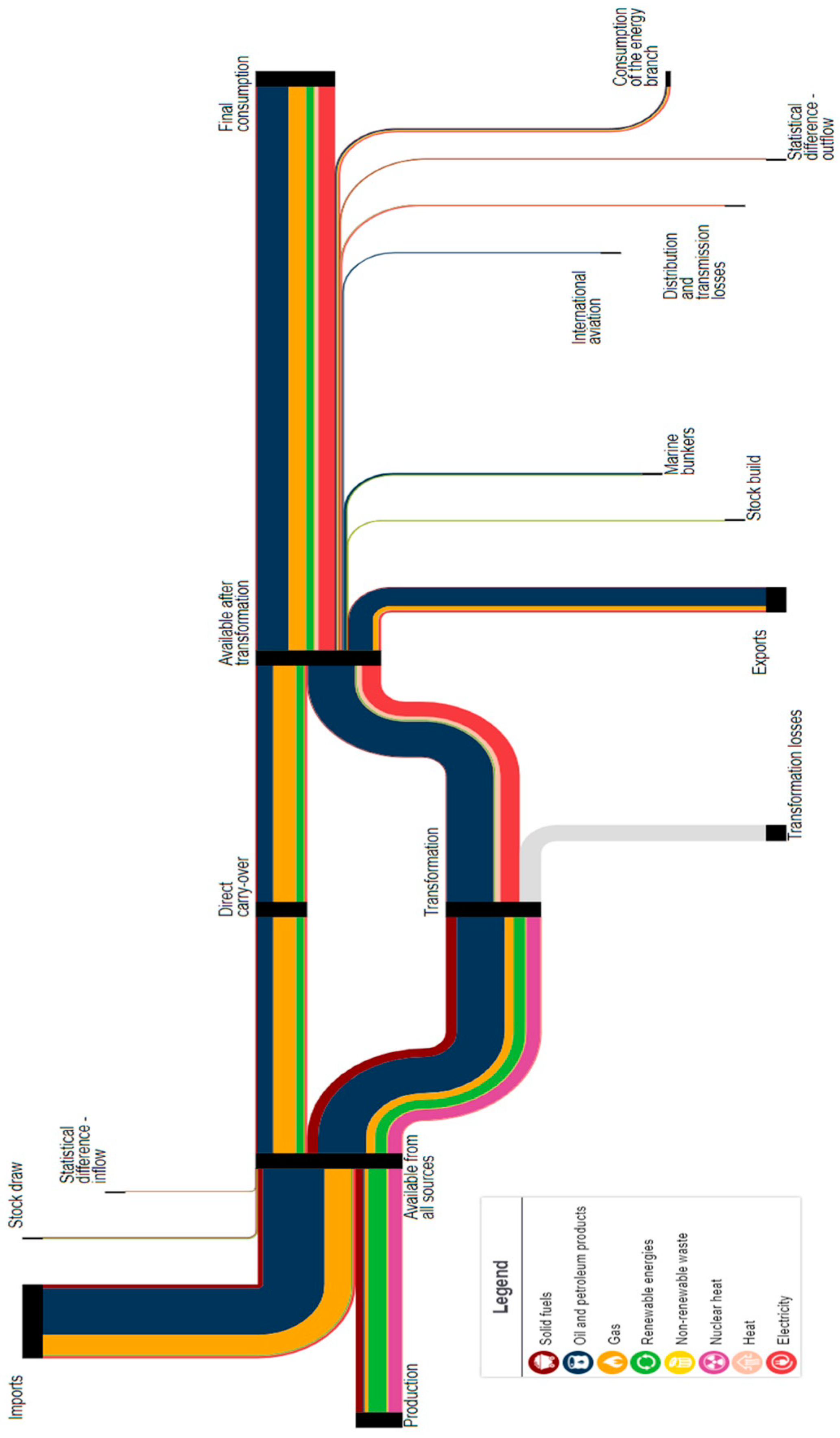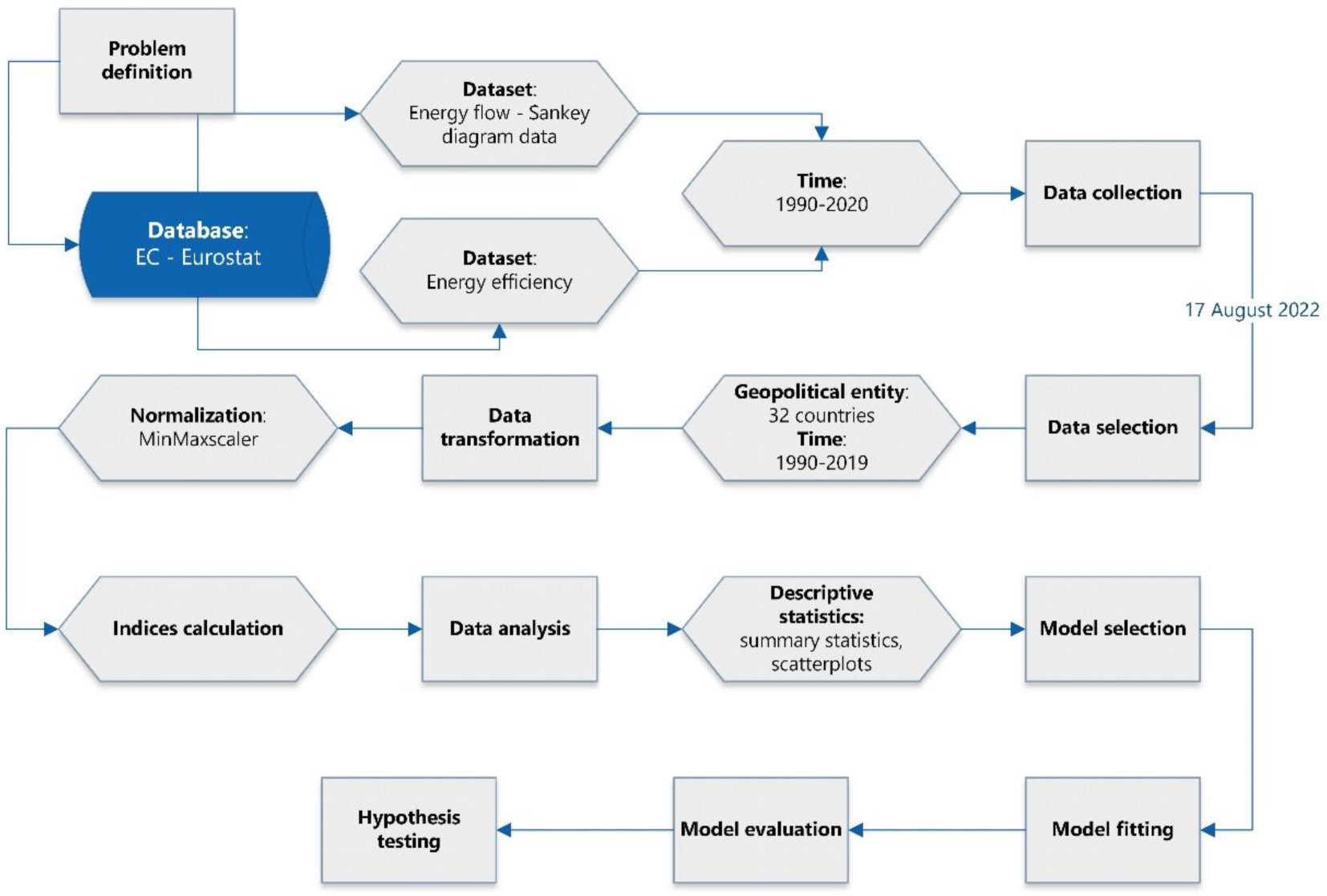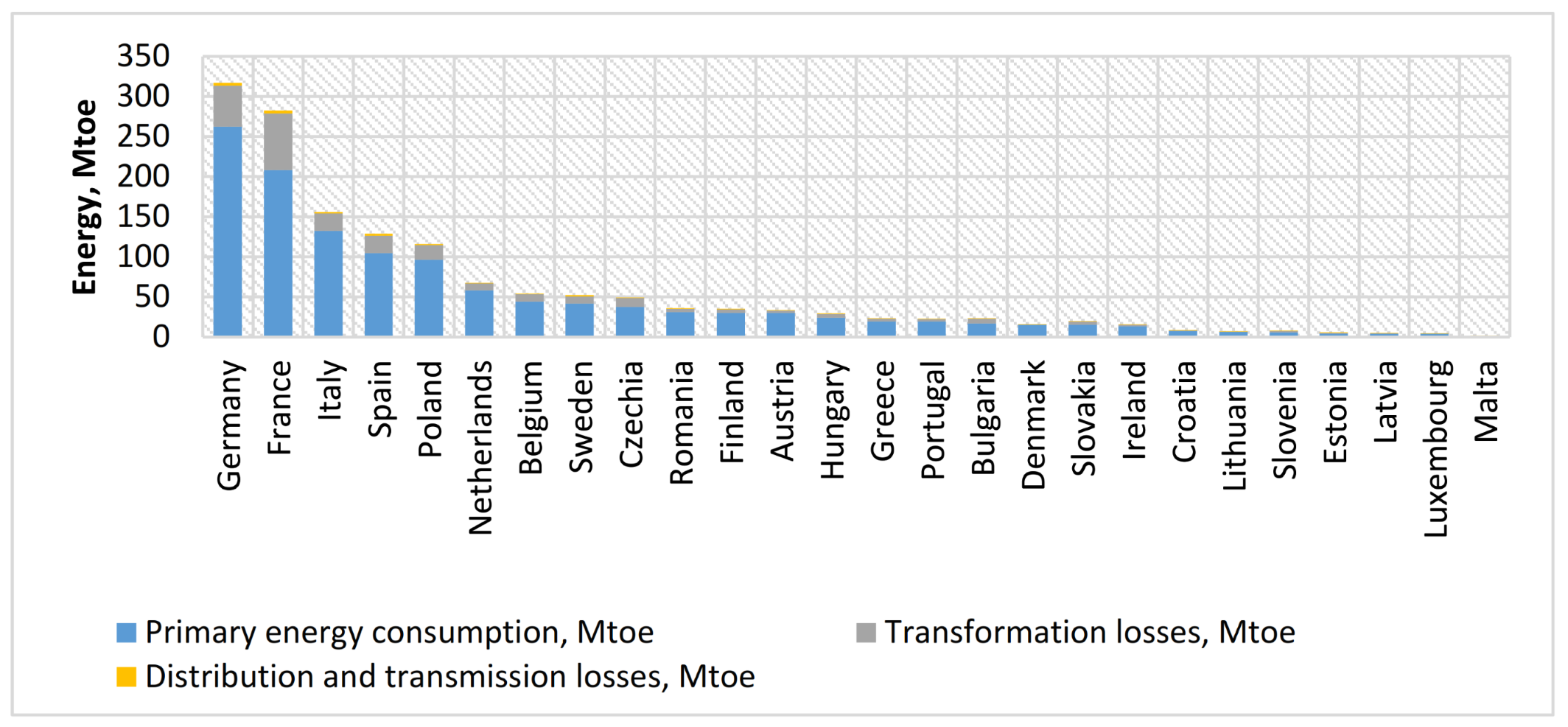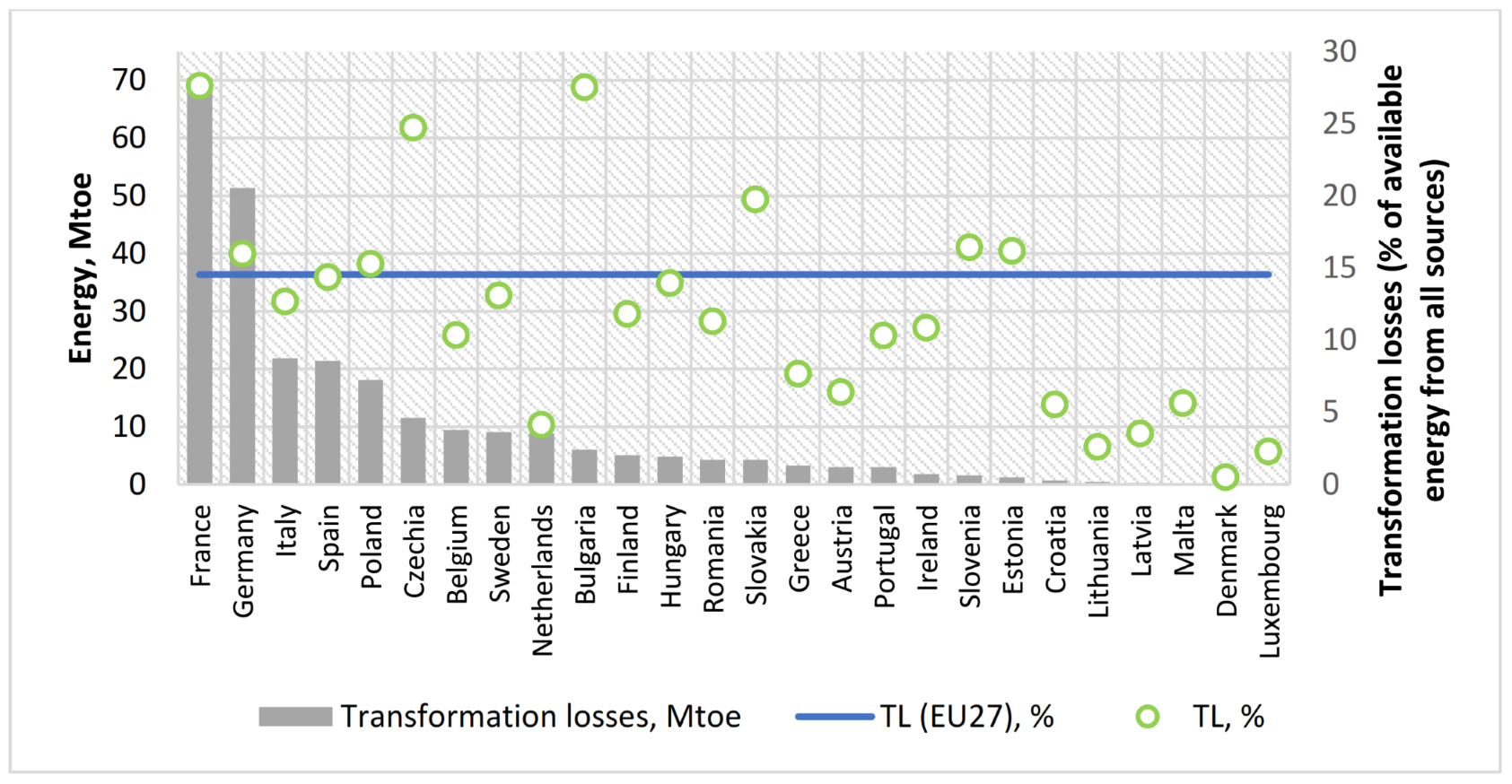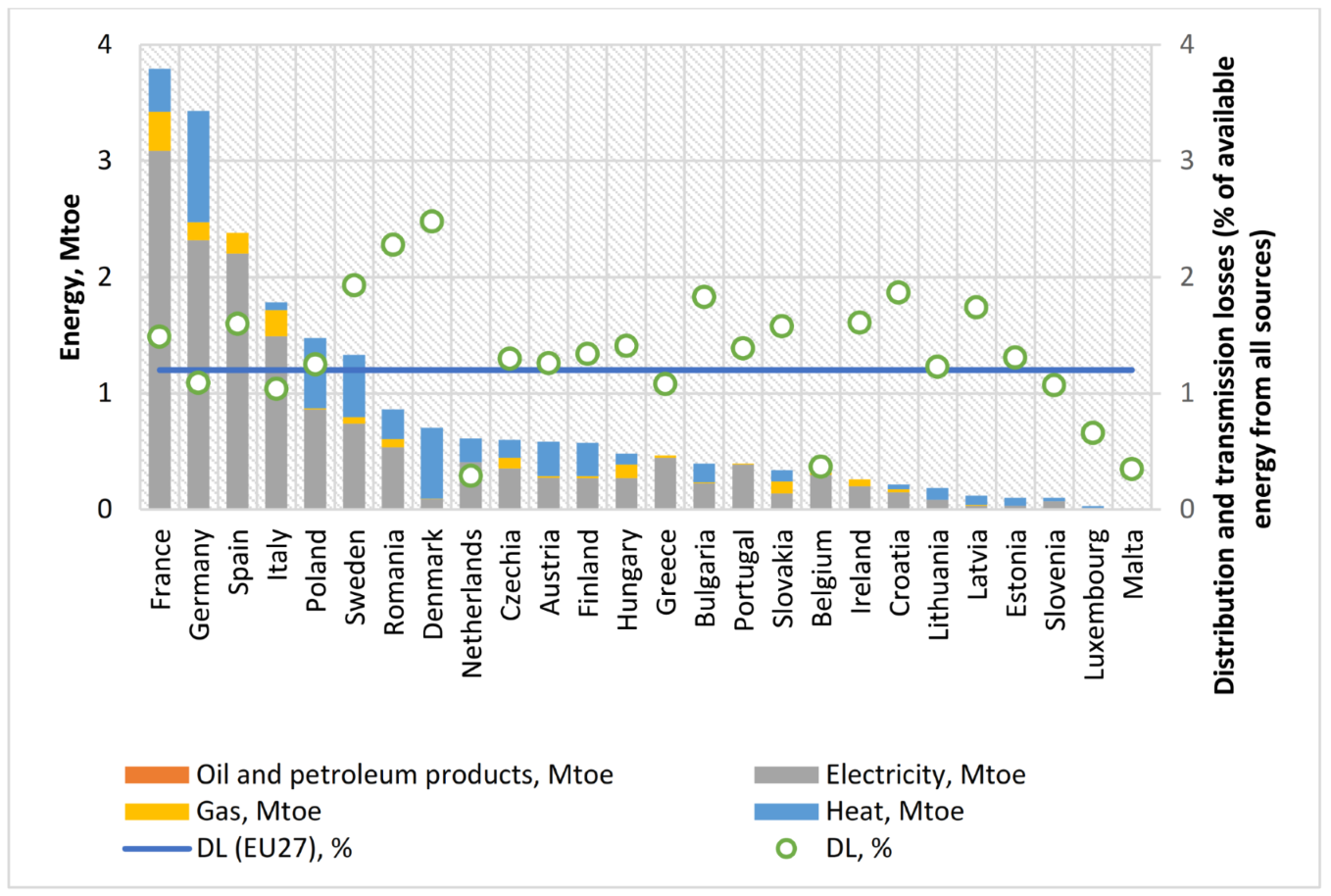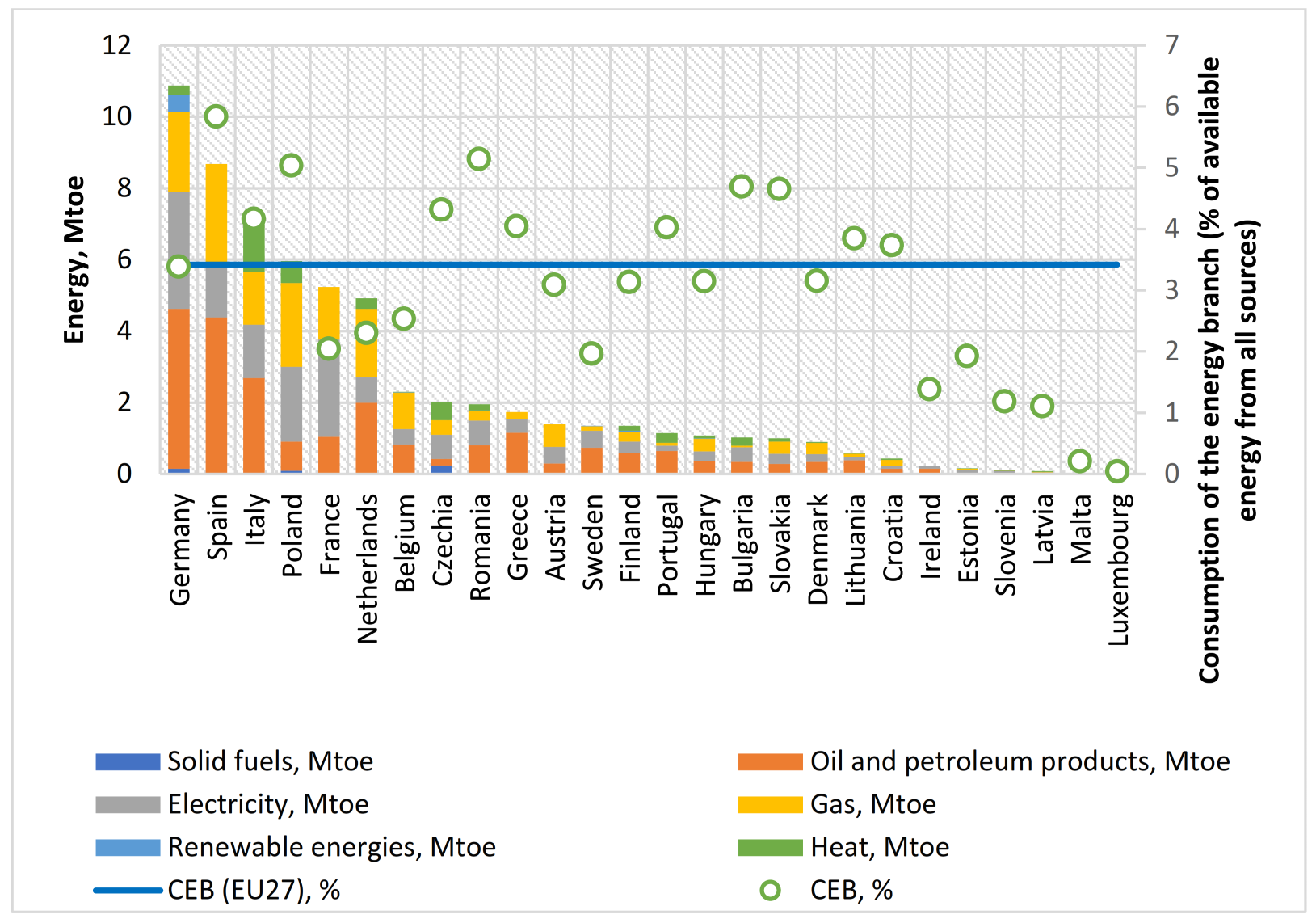1. Introduction
In these turbulent times, many European countries are using sustainable energy governance practices to reduce energy losses. The proper management of energy losses helps to decrease CO2 emissions, increase energy efficiency, improve environmental quality, and minimize energy infrastructure needs [
1,
2,
3]. Therefore, it is a priority to introduce energy-efficient strategies to reduce energy losses [
4,
5]. Increasing energy efficiency has a significant contribution to ensuring sustainability [
6,
7,
8], investment attractiveness [
9,
10,
11], and socio-economic development [
12,
13,
14]. In addition, the improvement of energy efficiency is accompanied by the development and application of solutions in the field of environmental taxes [
15,
16,
17], with particular attention to the topical issues of national security [
18,
19]. Since the problem of energy losses is the main reason for the financial collapse of most utility companies [
20], eliminating such losses directly impacts the economic well-being of regions and their energy security. Constant attempts to reduce and optimize energy losses are noticeable [
21]. The governments of countries with inefficient energy systems are forced to use smoothing mechanisms to mitigate negative energy shocks for the population, as such shocks threaten democratic processes [
22,
23].
At the current stage of development, it is necessary to make strategic changes to the energy system development plans [
24,
25,
26]. Such changes should be consistent with the global scenarios of the 2030 Agenda for Sustainable Development [
27]. In 2018, the amended Energy Efficiency Directive entered into force in the EU, which sets the main target to increase energy efficiency by at least 32.5% by 2030 [
28]. In 2022, in the context of the REPowerEU plan, the European Commission proposed to increase the EU target for energy efficiency by 4% compared to the baseline scenario for 2030. It takes a lot of effort to reach the 2030 targets [
29].
Each EU country has its scenario for reducing energy consumption, energy intensity, and energy losses by 2030. However, many problems remain unresolved and unexplored. One of them is significant energy losses in Europe. Energy losses can have negative impacts not only on the environment but also on efficiency [
30]. This paper aims to identify the relationship between energy efficiency and selected indicators of energy losses in Europe. The article sets out the hypothesis that there will be no difference in effect on energy efficiency between different indicators of energy losses in Europe. The results make it possible to understand the impact of sustainable governance in these countries on their energy efficiency and security.
This article is logically structured and contains four sections. The second section describes data, variables, and methods of this study. The third section shows the main results and discussion questions of the study. Conclusions are given in the last section of this study.
2. Materials and Methods
2.1. Data
This study analyzed 32 countries belonging to four regions of Europe, considering the availability of data: Eastern, Northern, Southern, and Western Europe. The authors downloaded data on energy losses during the distribution and transformation of energy in Europe on 17 August 2022, from the European Commission—Eurostat database “Energy flow—Sankey diagram data.” In total, this database contains 900,539 values. Annual data from 1990 to 2020 are available in most countries databases. However, the data for 2020 is much more incomplete. Therefore, a 30-year time horizon, from 1990 to 2019, was chosen for this study. The authors could not find data on energy loss during extraction and storage for the specified time horizon.
In general, the database “Energy flow—Sankey diagram data” contains a description of the energy balance components for 42 geopolitical entities. They include all member states of the European Union, EFTA countries, candidate countries, and potential candidate countries, as well as some Energy Community Contracting Parties. However, not all the countries represented in the database were considered in this study due to the partial completeness of the data of these countries according to the selected indicators. Regional groups and non-European countries (Cyprus, Turkey, and Georgia) were also excluded from this study.
Figure 1 shows the flowchart diagram of the research process.
In addition, the authors downloaded the energy efficiency indices, the volumes of energy consumption of the energy branch, and its non-energy use in final consumption from the European Commission—Eurostat database.
A description of the model input variables is presented in
Table 1. The model variables were normalized using a MinMaxscaler.
2.2. Description of the Variables
To achieve the goals of this study, the authors performed a preliminary statistical description of the variables. The results of the analysis are presented in
Table 2. As can be seen from
Table 3, the data were smoothed by minimax normalization. The scatterplots of the variables with marginal histograms are presented in
Figure 2.
Figure 2 shows that the input variables have a characteristic uniform probability distribution.
2.3. Methods
Current energy loss research focuses on determining the impact of various institutional, social, demographic, and economic factors. Multiple models and methods are used in scientific works to confirm this effect (
Table 3) empirically.
Based on previous studies [
31,
37], it is possible to determine energy losses (L) as a function of energy flows (X) for a certain period t (1):
where L
t is energy loss for a certain period t and X
t is a vector of energy flows {X
1, X
2, …, X
n} for a certain period t.
A visual representation of energy flows in the form of a Sankey diagram is available in
Appendix A. The authors used the SEEA-Energy methodology in this study to classify energy losses. According to SEEA-Energy [
38], all energy losses are divided into four groups (2):
where L
t is energy loss during extraction for a certain period t; L
dt—energy losses during distribution for a certain period t; L
st—energy losses during storage for a certain period of time t; and L
tt—energy losses during transformation for a certain period of time t.
In addition to energy losses, this study used the shares of energy consumption by the energy sector and its non-energy use in final consumption (in % of available energy from all sources) to indirectly assess energy efficiency.
After reviewing the literature and statistical description of the data, the OLS Model (3) was used for the purposes of the study:
where y is the dependent variable; X is a vector of energy flows {X
1, X
2, …, X
n}; and ε is an error.
The Jarque–Bera test was used to test the normality of the residuals, the Breush–Pagan test was taken for heteroskedasticity tests. Based on the results of using the test, the following hypotheses will be proven:
H0: Homoscedasticity is present.
HA: Heteroscedasticity is present.
The authors performed hypothesis testing, model evaluation, and data visualization using Python programming language libraries.
3. Results and Discussion
In the first stage of the research, the statistical significance of the indicators was analyzed. The descriptive statistics of the values are given in
Table 4.
The two variables were excluded from the model considering the
p-value in
Table 4: CEB and DL. The results of the second stage of optimization are presented in
Table 5.
Table 6 shows the main results of model testing. Since the
p-value of the Breush–Pagan test is less than α = 0.05, the authors reject the null hypothesis and conclude that the regression model is heteroscedastic.
The results clearly show significant heterogeneity between European countries in terms of energy efficiency and energy loss coefficients. Current changes in energy systems aimed at increasing the use of variable renewable energy have far-reaching consequences for all its elements [
39,
40,
41]. Any segments of energy systems face new problems of security, flexibility, and capacity [
42,
43]. In the future, because of climate change and in the context of the energy transition, the entire electric power infrastructure may become more vulnerable to failures and will require an increase in its long-term security [
44]. The energy consumption structure may reveal vulnerabilities and balance issues affecting a country’s energy security [
45]. If we consider the case of the EU in 2020, slightly more than 80% of primary energy consumption in the EU-27 was utilized by end users. Although the main electricity losses in the EU have decreased, they are still significant. Thus, losses from the transformation and distribution of electricity amounted to 15.74% in 2020 compared to 20.44% in 1990. Moreover, since 1990, losses from electricity transformation have decreased and those from distribution, on the contrary, have increased in 2020. The share of energy losses during its transformation, distribution, and transmission varies significantly in different countries of Europe (
Figure 3) and other countries of the world. According to the research by Shaw-Williams et al., the efficiency of transformation networks is much higher than that of distribution. The authors explain this situation by the fact that when transporting energy over long distances at higher voltages, the efficiency should also be higher [
38]. However, empirical data from European countries indicate otherwise. In 2019, in some European countries, more than 42% was lost during energy transformation (
Appendix B), while less than 4% was lost during energy distribution. In 2020, the leaders in absolute energy losses from transformation and distribution were five countries: France, Germany, Italy, Spain, and Poland (
Figure 4 and
Figure 5). It seemed that such data could indicate the inefficiency of the energy sector of these countries. However, not everything is so clear-cut. Given the high share of imports of energy resources in some European countries, these countries will not experience losses from energy generation. Small shares of energy losses during energy transformation can be accompanied by significant energy dependence of European countries due to high shares of energy imports (
Figure 6).
Since 1990, there has been a long-term trend of increasing dependence on energy imports in the EU27. The gross available energy in the EU has fallen over the past decades, mainly due to the reduction in the production of solid fossil fuels. The EU imported energy in 2020 by 7.5% more compared to 1990 [
46]. Increasing the share of energy imports has allowed many countries to meet established requirements to reduce greenhouse gas emissions. As energy transformation losses are part of the energy-producing country’s transformation sector [
47], energy-dependent countries will not suffer significant energy generation losses. Since energy resources are sometimes imported with a high unilateral dependence on individual countries, such as Russia, this leads to the deterioration of energy security in countries [
48].
The European Commission has been implementing measures aimed at strengthening the energy security of EU member states and introducing green innovations for a long period [
49]. In 2015, the European Commission proposed an energy union project to reduce energy dependence on Russia because of the Russian–Ukrainian gas dispute in 2009. However, the energy networks of the EU member states are still separated. Each country independently determines its energy policy, the structure of the energy system, and the volume of energy imports. Usually, governments are not interested in the idea of an energy union because of the desire to achieve their own national interests. Some countries support strengthening economic and political relations with Russia [
50]. However, now, the priorities of European energy policy and security have changed. The world is experiencing an energy crisis due to Russia’s invasion of Ukraine. To mitigate the negative consequences of the crisis, the use of coal and oil in electricity generation is expected to increase in the short term. In 2022, the world production of atomic energy decreased by more than 80 TWh due to a series of shutdown of nuclear power plants [
51]. To reduce energy dependence on Russia in the long term, in Europe, there will be additional investments in gas projects. Since natural gas is seen as a source of carbon footprint reduction, such investments should increase energy security and help meet climate goals [
52].
The consumption of electricity by the energy sector has also decreased in the EU-27. In 1990, such electricity consumption was 4.03% compared to 3.42% in 2020. The consumption of the energy branch in 2020 is shown in
Figure 7. Energy losses can be technical, that is, due to the technical parameters of energy systems, and non-technical [
53,
54], that is, energy losses due to theft, fraud, errors in billing, or due to non-payment of energy bills. There is an opinion that non-technical energy losses are more significant for developing countries and less for developed countries [
55]. According to Antmann’s work, in developed countries, most of the population can pay the established tariffs for energy resources. Therefore, non-technical energy consumption is minimal [
56]. In addition, most high-income countries impose significant fines and prison terms for electricity theft [
57]. In developing countries, the situation is not unambiguous [
58,
59]. Many organizations in the field of electricity (electricity utilities) are efficient and such that they can reduce non-technical energy losses. However, there are also organizations with very high non-technical losses [
60]. Savian et al. argue that in countries with an upper-middle income compared to countries with a high-income level, the corruption level among employees of energy distribution companies is also higher. In low-income countries, the possibility of a high level of corruption on the part of inspection agents in the energy field is even more significant [
61]. However, there is another point of view on the nature of non-technical costs. According to Car and Thomson, the assumption that the underlying nature of non-technical expenses is due to the accumulation of unpaid bills by the poorest households is a simplification. Their study showed that the largest share of non-technical expenses was caused by the wealthiest customers, large enterprises, and state-owned enterprises [
62]. The economic value of energy resources only increases over time. Such value is measured not only and not so much by their price but by enormous indirect consequences. Loss of energy or power outages can lead to health problems [
63], loss of environmental safety [
64,
65,
66], and ecological impacts.
4. Conclusions
The analysis of the issues of sustainable management, energy security, and energy losses is essential for understanding the trajectory of the green transition and energy efficiency of European countries. Given the numerous crises in the energy field related to the prices and availability of energy resources, increased attention and publicity will need to be given to the problems of energy losses in the future. It is necessary to develop common standards for regulating energy losses to guarantee European energy security. Building a sustainable pan-European energy system is impossible without all European countries’ effective use of energy resources. Unfortunately, the level of energy efficiency and energy losses varies significantly between countries.
Using the OLS testing of energy efficiency and selected endogenous indicators, the authors investigated variables to explain energy losses in Europe over the last thirty years. The simulation results led to three main conclusions, namely:
1. There is a linear relationship between European energy efficiency and the energy transformation loss index.
2. An increase in distribution losses (% of available energy from all sources) by 1% in Europe leads to an increase in energy consumption by 17.16% under other constant conditions.
3. The test results confirmed the hypothesis of heteroskedasticity of the regression model. The model’s results were checked using the Breush–Pagan and Jarque–Bera tests and showed the adequacy of the model.
Given the significant heterogeneity of the structure of energy losses in European countries, it will be helpful in further research to examine clusters of countries by the level of their energy losses.
